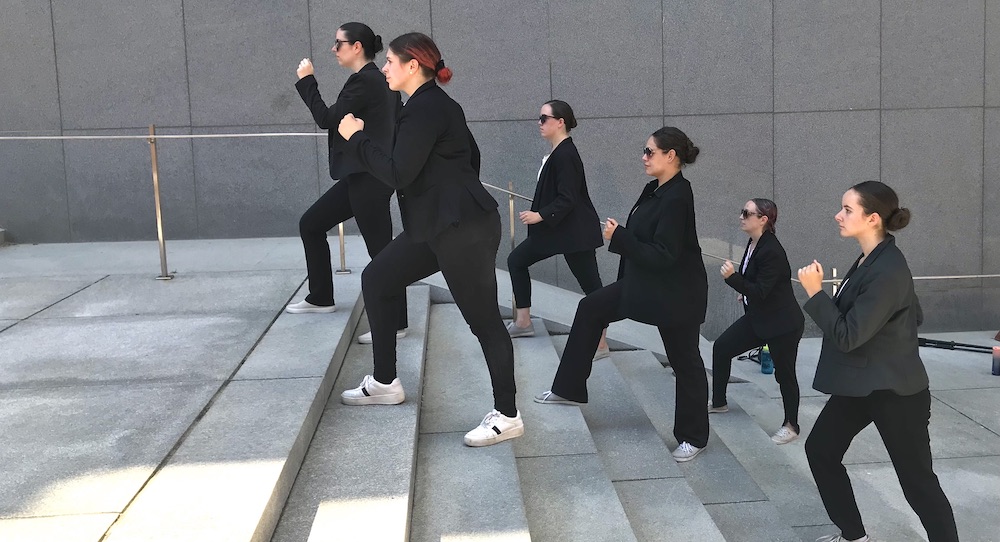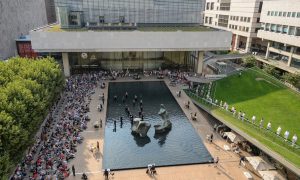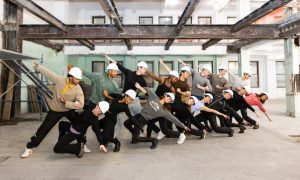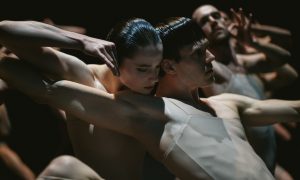July 23-July 27, 2021.
Streaming on YouTube.
One might think that artists having a voice is just something that naturally happens. Art involves a good deal of personal expression, right? Yet, COVID has led me to think about how artists do or don’t have a voice and choice — and therein how they’re empowered or not empowered.
While movies, television, books, music and TikTok dance videos got us through the pandemic, artists saw much of their livelihoods and what they love doing slip from their grasp. That’s just one example of how a context of expression doesn’t necessarily offer voice, choice and empowerment.
Yet, the 3rd Annual Empower One Another, a virtual program of dance films co-directed by Boston-based artists Gracie Baruzzi and Jennifer Kuhnberg, offers a model for how to offer artists those things. This annual program’s goal is to offer opportunities, access and collaborative spaces to female choreographers in the Boston area.
Evincing an atmosphere of creative exploration and openness to various approaches and products, each work has a unique character and vibe — the product of an empowered artistic voice. Video introductions from the artists deepen understanding of particular works — also a literal opportunity to have a voice.
Yet, some works don’t have a video introduction — presumably the result of choice to take that space for one’s voice or not. All of the works are poignant, commendably crafted and enjoyable — what can happen when artists are truly empowered with voice and choice. The following works are those in the program that especially resonated with me.
The Effort it Takes, by Kuhnberg and Abigail Ripin, wittily portrays the physical effort in everyday movement — a theme that Kuhnberg also explains in a video introduction from the two choreographers. The work begins with various shots of stairs, escalators, elevators and inlets in a brick wall.
Dancers enter the frame and begin to move — in pathways toward a specific physical goal, with clear, angular direction in facings and locomotion. They remain mainly expressionless, which adds to a feeling of them as manifestations of physical effort rather than specific human characters or archetypes.
These qualities quickly resonate with me; when we’re climbing stairs or riding an escalator or walking down a long hallway to an elevator, our direction and goal are clear. There can almost be a meditative quality in that, the mind focusing on the body’s work. Supporting that tone is the upbeat score with a sense of repetition (“Outcast” by Bonobo). We can enjoy how we call upon our bodies to move through the world and support us each day.
What also intrigues me is this piece in the context of COVID, which led to less of that moving through the world. This movement meditation could refocus us on a perspective of gratitude for the mundane ways our bodies work as we move through the world — those which they couldn’t over the course of a global pandemic.
Huntress from Alchemy Movement Company, choreographed by Mariah Rasmussen, illustrates the raw power in a woman’s mind, body and spirit. Five women move with strength and precision, on a sparse stage under dimmed stage lights. As a compelling structure, visually and energetically, the action and direction of a soloist juxtaposes that of the four other dancers. The collective is in tension with the individual. Yet, at times, they do come together in unison; life and behavior within groups tends toward cycles.
Another intriguing juxtaposition is that between strength-based and angular movement, primal in quality, and that which is more fluid and curvilinear. Even at once, they lunge deep — powerful through their legs and their placement exact, for an earthy feel — while their arms move in a wave-like fashion, initiating from the shoulders. I think about a larger juxtaposition at play, in the sense of hunting (also reflecting on the title) — of killing to live.
Alone Together comes next, a collaboration between Monkeyhouse and Collective Moments Dance. Kaylee Mahan and Sarah Feinberg, in collaboration with the dancers, contributed choreography. The work brings a unique approach to a common structure within COVID film dance; the movement of several dancers, dancing alone in their own space, is cut together in refined and satisfying approaches: fading from one dancer to another, box shapes intersecting and moving past each other in various ways.
Within the movement itself, dancers execute a common movement phrase yet take it on their timing. It’s compelling how the same phrase is therefore in conversation with itself through alternate timings. In shape and quality, the movement conveys hitting an obstruction, moving another way, reaching and exploring through the body or the desire to do so more.
As the dancers move little from one spot, they fall to rise again — with finesse and power. Such adaptation and perseverance in the face of challenge is certainly something we can relate to through COVID. Short of concrete meaning, the work is energetically and visually pleasing.
81 Cents, from Nozama Dance Collective and choreographed by Artistic Director Dana Alsamsam, is a solo of one woman facing a turning point moment and moving through all of the feelings that it brings. Highly theatrical, it also offers intricate movement and technical chops. The woman (danced by Olivia Moriarty) steps out of heels in her kitchen, as if getting home from a long day at a very formal job. Small items that evoke an active home — pens, paper, trinkets — build the sort of specificity that can create something universal.
She stops short, accented but with dynamic, attuned stillness, and then fluidly moves in another direction. There’s a continuity from accent to accent as she moves. Her movement is not quite expansive physically, being more internally focused — yet her energy and presence fills the space.
Suddenly, she rips the paper as if rejecting a message from a loved one. In that there’s anger, to be sure, but also about her is a thoughtfulness and reflective quality. All of that accompanied by a somber and reflective tone in the score (Billie Eilish’s “when the party’ over”) amplifies those qualities and emotional depths.
I think about those times when we face hard moments and yes, we’re upset, but we’re more so just feeling totally unsure as to which of the bad available options to take. Design elements, movement vocabulary, and a remarkable performance from Moriarty come together to translate all of that meaning and emotional weight to me — without a word spoken.
Uplift from Baruzzi and Natalie Schiera illustrates the joy and positivity between two friends, and therein is indeed quite an uplift. I know the two artists to be longtime close friends and collaborators, so I smile to see them working together here. The instrumental score (“Lisa” by factor eight) is quite uplifting, aptly enough — accompanying Baruzzi and Schiera’s strong, joyful movement and presence.
They wear costumes of simple colors and cuts; they come as they are, and that’s more than enough. The simplicity of this work’s concept and design demonstrates that even — and sometimes especially — within simplicity there is profound beauty. Yes, that can very much uplift us.
They feel elevated in movement quality, from the strong foundation of a grounded base. Dancing independently much of the time, the two performers are nevertheless in harmonious sync. When they do come together, they support each other through lifts. To me, that characterizes the most sustainable and fulfilling friendships — each person dancing to whatever drum they may, but there to support each other always.
Baruzzi and Schiera also wear masks, bringing COVID and its effect on how we can stay connected with those in our lives. Friendships and other close relationships have certainly been strained through this time, yet it’s also presented opportunities for us to investigate what friendships really are to us — and who we know can lift us up and gently rest us down.
At Play comes next, danced and choreographed by Natalia Maldari, Amy Foley and Teresa Fardella. It’s a lovely painting in movement of carefree, child-like joy through the body’s possibilities. The trio dances over grass, concrete and other structures in a park — moving with lifted and light movement vocabulary. There’s unison as well as effective opposition in their dancing.
Particularly pleasing are the moments when two dancers are in unison and the third dancer is doing something else synchronously — visually and energetically satisfying, but also true to the behavior of children in groups. Apart from the technical dancing, the film is imbued with all kinds of movement: other people moving in the background, wind moving through the trees, and even kites towards the end.
Accompanying the dancers throughout the film, the instrumental score (“Perpetuum Mobile” from Penguin Cafe Orchestra) is the kind which can make me smile no matter what’s happening in my day. The dancers themselves have an easy smile as well, and offer an overall jovial, youthful sense.
Adding to that feeling, and making me smile even bigger, they wear floral rompers just like children might wear — before age and fashion norms might stop us from wearing something so bright and cheerful. Dance can challenge us, make us think, and call attention to things in the world or about ourselves that it’d behoove us to change — but it can also simply make us smile. Let’s not forget that.
Polyphony, featuring the dancers of Nozama Dance Collective and choreographed by Nora Le Guen, is a memorable illustration of a concept effectively realized in movement. Dancers find their own timing and qualities within unison movement, and at other times there’s a polyphony in movement — separate dancers executing different movement vocabulary synchronously. Through dynamism and intricacy, one could see polyphony within the movement vocabulary itself.
In various bright colors, with each color unique to each dancer’s costume, the costumes convey that sort of variegation as well. In harmonious alignment, the score itself (“Pulchra es Amica Mea / Northern Lights” by Nate Tucker) is certainly polyphonous — with various musical influences, from jazz to electronica, and with varied harmony lines layered together. Even the setting conveys a multiplicity, with the open expanse of the outdoors offering a sense of boundless possibilities.
In something less layered but equally impactful towards the end, the dancers walk in a circle pattern with their elbows bent, gazing at their forearms. With this focus and intentionality comes a clarity of effect — a shift from many influences and ingredients simultaneously at play to a singular element dominating. All in all, the film is an intriguing and unparalleled embodiment of a musical concept — all coming together to something poignant and resonant.
Just like in all works in the program, these artists shared something that could hit the eyes, heart, and mind in a memorable way — the sort of transcendent, indefinable magic that can happen when artists are empowered enough to speak authentically and to have choices over how they speak. Brava and thank you to all artists involved with the 3rd Annual Empower One Another for bringing those important truths front and center!
By Kathryn Boland of Dance Informa.















